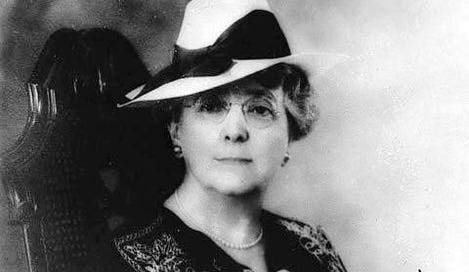Anne of Green Gables is a beloved book. Readers fell in love with the story and main character right from the very beginning, when it was first published in 1908. Since then, the book has become a literary classic, captivating generations of readers with charm and spirit. It has even helped shape young adult literature, introducing a heroine whose imagination, intelligence, and determination resonated across time.
The author behind the book was Lucy Maud Montgomery.
Born on Prince Edward Island in 1874, Lucy’s childhood was shaped by both tragedy and imagination. Her mother died of tuberculosis before Lucy turned two, and her grief-stricken father left town alone, placing his young daughter in the care of her strict grandparents in the rural town of Cavendish.
There, in a house overlooking the island’s rolling fields and red cliffs, Maud, as she preferred to be called, found solace in books and the natural beauty around her. Often left alone, she developed a deep inner world, filling her solitude with stories she created in her mind.
By teenage years, Maud had begun writing in earnest, filling notebooks with poetry and short stories. She later wrote in her autobiography that storytelling ran in the family and that she had inherited the talent from her relatives. But Maud was also encouraged by a teacher, and as a result, submitted her first poem for publication at the age of 16. It was accepted by a local newspaper.
After high school, Maud pursued higher education, enrolling in Prince of Wales College, where she completed the two-year teaching program in just one year, graduating with honors. Then, she worked as a schoolteacher in small rural communities, a common path for educated women of her time.
Teaching provided financial independence, but her true passion remained writing. In the evenings, after long days in the classroom, she filled pages with poetry and prose, submitting stories to magazines across Canada and beyond. The rejection letters piled up, but so did her determination.
In 1895, Montgomery took a bold step and enrolled at Dalhousie University in Halifax, Nova Scotia, to study literature. But after a year, financial constraints forced her to return to Cavendish. There, she continued teaching while also caring for her ailing grandmother. And just as before, she continued writing, publishing hundreds of short stories and poems in literary magazines, building a reputation as a skilled storyteller.
In 1905, she wrote a novel inspired by a childhood anecdote about an orphaned girl mistakenly sent to a family expecting a boy. She expanded on that small idea, bringing to life the spirited Anne Shirley in Anne of Green Gables. Confident in her work, Maud submitted the manuscript to several publishers, only to receive rejection after rejection.
Undeterred, she set the manuscript aside in a hatbox for two years before trying again. In 1907, she sent it to L.C. Page & Company in Boston, and this time, the response was different. The publisher saw potential in the novel and agreed to print it. When Anne of Green Gables was released in 1908, it became an immediate success, selling over 19,000 copies in its first five months. It was just the beginning.
Ironically, though, Maud didn't consider Anne of Green Gables her best work. That honor went to Emily of New Moon. “It is the best book I have ever written—and I have had more intense pleasure in writing it than any of the others—not even excepting Green Gables. I have lived it, and I hated to pen the last line and write finis," Maud wrote about it.
Years later, Maud would be asked by an editor to write her autobiography. She obliged and began the story with the following:
"WHEN the Editor of Everywoman's World asked me to write ‘The Story of My Career,’ I smiled with a little touch of incredulous amusement. My career? Had I a career? Was not — should not — a ‘career’ be something splendid, wonderful, spectacular at the very least, something varied and exciting? Could my long, uphill struggle, through many quiet, uneventful years, be termed a ‘career’? It had never occurred to me to call it so; and, on first thought, it did not seem to me that there was much to be said about that same long, monotonous struggle. But it appeared to be a whim of the aforesaid editor that I should say what little there was to be said; and in those same long years I acquired the habit of accommodating myself to the whims of editors to such an inveterate degree that I have not yet been able to shake it off. So I shall cheerfully tell my tame story. If it does nothing else, it may serve to encourage some other toiler who is struggling along in the weary pathway I once followed to success."
Sources:
“Beauty And Mischief In 'Anne Of Green Gables'.” NPR Weekend Edition, https://www.npr.org/2008/08/02/93148044/beauty-and-mischief-in-anne-of-green-gables
Krzewinski, Agatha. “100 Years of Emily of New Moon.” Anne of Green Gables, https://www.anneofgreengables.com/blog-posts/100-years-of-emily-of-new-moon
Library and Archives Canada / C-011299 - Wikimedia Commons, Wikimedia Foundation, https://commons.wikimedia.org/wiki/File:LMM_signed_photo.jpg
Montgomery, Lucy Maud. Anne of Green Gables. United States, Grosset & Dunlap, 1908.
Montgomery, Lucy Maud. The Alpine Path: The Story of My Career. United Kingdom, Fitzhenry & Whiteside, 1974.





PEI was inundated with tourists from Japan, eventually going to Cavendish, and couldn't figure out why. Turns out everyone learning English read Ann of Green Gables as part of their course work and wanted to visit Cavendish and see Green Gables Heritage Place. Who knew she would provide a tourist draw for the town? PEI is a really neat place.
It's such a sweet and timeless story.